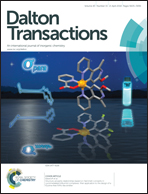Development of a novel chiral palladacycle and its application in asymmetric hydrophosphination reaction†
Abstract
A novel amine ligand, 1-(2,5-dichlorophenyl)-N,N-dimethylethanamine, was synthesized from 1-(2,5-dichlorophenyl)ethanone via a three step synthetic route. Direct ortho-palladation of the amine ligand with Pd(OAc)2 gave the racemic dimeric complex in high yield. This racemic palladacycle was efficiently resolved through the formation of its (S)-prolinato derivatives. The resulting diastereomeric complexes were separated efficiently by column chromatography. In the solid state, the structure and absolute configuration of the two optically resolved palladium complexes were determined by single crystal X-ray crystallography. In solution, their absolute conformations were also investigated by the 2D 1H–1H rotating frame nuclear Overhauser enhancement (ROESY) NMR spectroscopy. Both (R,R) and (S,S)-di-μ-chloro dimeric palladium complexes could be obtained chemoselectively by treating the corresponding prolinato derivatives with dilute hydrochloric acid. The amine auxiliary could be subsequently removed from the palladium center by treatment with concentrated hydrochloric acid. The enantiomerically pure palladacycle was used to promote the asymmetric hydrophosphination reaction between diphenylphosphine and dimethyl acetylenedicarboxylate. The 31P{1H} NMR spectroscopy indicated that only one stereo-isomeric product was formed.


 Please wait while we load your content...
Please wait while we load your content...